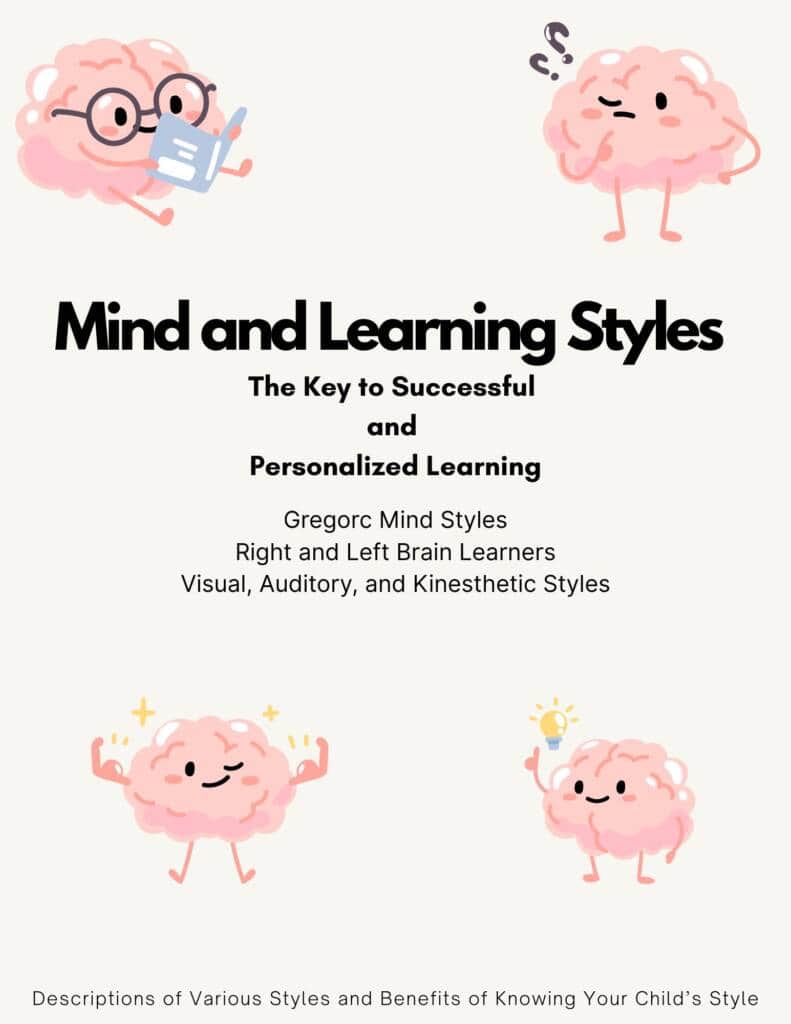This post about the Classical Homeschool Method is the first post in a 10 part series about different homeschooling methods.
This series will include the following homeschooling methods:
- Classical Homeschool
- Charlotte Mason
- Montessori
- Unschooling
- Traditional or School at Home
- Project Based Learning
- Eclectic or Mixed Approach
- Unit Studies or Thematic
- Delight Directed or Interest Led Learning
- Waldorf
Understanding the Classical Homeschool Method: A Timeless Approach for Homeschool Families
If you’ve been researching and trying to figure out which homeschool method is right for you and right for your child’s learning style and like the idea of a traditional and structured method approach and curriculum, then the Classical method may be exactly what your family needs.

To assist you in determining your child’s best learning methods and curriculum, this free ebook will help you.
With its roots in ancient teaching methods and a proven track record of producing articulate and well-rounded individuals, Classical Education is a favorite among families who value structure and critical thinking.
But what exactly is Classical Education? How does it work in a homeschool setting? And is it the right fit for your family?
Let’s unpack the Classical model and discover why so many homeschooling families have embraced this time-tested approach.
What Is the Classical Homeschool Method?
Classical Education is a model of learning that has been practiced for centuries. Rooted in the traditions of ancient Greece and Rome, Classical Education provides a structured study of the liberal arts and the “Great Books” of Western civilization. You might be familiar with Socrates and the “Socratic method” and the emphasis on rhetoric (the last stage in this type of education method).
This educational approach is built upon the Trivium, a three-part process that aligns naturally with a child’s cognitive development. The Trivium consists of:
- Grammar Stage (roughly ages 5–10)
- Logic Stage (roughly ages 11–14)
- Rhetoric Stage (roughly ages 14–18)
Each stage emphasizes a different skill set and builds upon the one before it. Let’s look at each in detail.
The Trivium: A Roadmap Through Classical Learning
Grammar Stage: Laying the Foundation (Elementary Years)
In the Grammar stage, children are like little sponges. They love memorizing facts, reciting poems, and learning songs. The Classical Homeschool method takes advantage of this natural inclination by focusing on foundational knowledge. In this stage, children are introduced to the basic facts and rules of various subjects—math facts, grammar rules, historical timelines, science classifications, and more.
Key Features:
- Emphasis on memorization and repetition
- Use of chants, songs, and rhymes
- Exposure to classic literature and read-alouds
- Introduction to Latin and sometimes Greek
- Copywork and dictation to reinforce grammar and spelling
The goal here isn’t just rote memory for its own sake—it’s to fill the child’s mind with the building blocks of knowledge. These facts serve as the foundation for deeper thinking and analysis later on.
Logic Stage: Developing Thinking Skills (Middle School Years)
As children enter adolescence, they naturally begin to question the world around them. They want to know why things happen, how ideas connect, and cause and effect. This is the perfect time to introduce logic and critical thinking.
Key Features:
- Study of formal logic and reasoning
- Analyzing arguments in literature and history
- Developing the ability to debate and defend a viewpoint
- More complex grammar and writing instruction
- Continued Latin studies to deepen understanding of language structure
In this stage, students are guided to make connections between facts they’ve learned and start thinking analytically. This is the time for Socratic dialogue, thought-provoking questions, and discussion-based learning.
Rhetoric Stage: Expressing Ideas Persuasively (High School Years)
In the final stage of the Trivium, students are ready to synthesize their knowledge and express it eloquently, where they take what they’ve learned so far and make it their own. This is the time to refine their communication skills, both written and oral. They are encouraged to develop their own opinions and articulate them clearly and convincingly.
So, if you have a natural debater in your household (a number of teenagers fit this description), this is a perfect time to perfect those skills!
Key Features:
- Advanced composition and essay writing
- Public speaking and persuasive speech
- In-depth study of philosophy, theology, and political thought
- Reading and discussing classical texts from Plato to Shakespeare
- Capstone projects and independent research
The Rhetoric stage produces confident, well-spoken young adults who can think for themselves and communicate effectively—skills that will serve them for life.
Why Choose Classical Education?
There are many reasons families are drawn to the Classical Homeschool method. Here are just a few of the benefits:
1. It Develops Critical Thinkers
The emphasis on logic, argumentation, and classic literature fosters analytical thinking. Classical students are trained not just to absorb information, but to question it, evaluate it, and engage with it.
2. It Builds Strong Communicators
From early copywork to formal rhetoric training, students learn how to express themselves clearly and persuasively. This is a huge advantage in college, the workplace, and everyday life.
3. It Respects the Stages of Child Development
The Trivium aligns naturally with a child’s cognitive growth, allowing students to thrive in each stage rather than being rushed or held back.
4. It Honors Tradition and Truth
Classical Education doesn’t chase trends. Instead, it looks back to the wisdom of the past, teaching students to wrestle with timeless ideas and eternal truths.
5. It Encourages Moral and Intellectual Virtue
By engaging with the great thinkers of history and discussing the big questions of life, students are challenged not only to think well but to live well.
Is the Classical Homeschool Method Right for Your Family?
Classical Education isn’t for everyone, and that’s okay. It’s important to match your homeschool style and your child’s learning and thinking styles with your family’s needs and values. Look below for a resource I have developed to help you determine your child’s learning and thinking styles and which homeschool method would be the right approach for them.
That said, here are some signs Classical Education might be a good fit:
- You value academic rigor and a strong intellectual foundation.
- You appreciate structure and long-term planning.
- You want your children to be exposed to the great works of Western literature and thought.
- You enjoy discussing big ideas and asking deep questions.
- Your children show an interest in reading, writing, or debate.
- You’re willing to invest time in subjects like Latin, logic, and classical literature.
How do I know if classical education is right for my child?
Here is a resource I created to assist you in determining your child’s learning and thinking styles with assessments and descriptions, and which homeschool method and curriculum is the right for one for them. You will find descriptions of various learning and thinking styles, assessments to determine your child’s styles, suggested teaching methods, materials, and curriculum with links for you to consider that match your child’s styles.

Getting Started with Classical Homeschooling
If you’re interested in using a Classical Homeschool method in your homeschool, here are a few steps to help you begin:
1. Read and Learn
Start with some foundational books like:
- The Well-Trained Mind by Susan Wise Bauer and Jessie Wise
- Consider This by Karen Glass
- The Lost Tools of Learning by Dorothy Sayers (a short essay that inspired much of the modern classical movement)
These resources will help you understand the philosophy and practical application of Classical Education.
2. Choose a Curriculum
You can go with an all-in-one program or build your own with resources from trusted publishers. Look for materials that align with the Trivium stages and your child’s learning level.
3. Start Simple
If you’re transitioning from another homeschool style or just starting out, don’t try to do everything at once. Start with one or two subjects (like Latin and literature) and build from there.
4. Join a Community
Many Classical homeschoolers find support through co-ops, online forums, or Classical Conversations groups. These communities offer encouragement, resources, and accountability. And, of course, are great for discussions as part of the classical learning method!
Classical Homeschool Curriculum: The Tools of the Trade
The Classical Homeschool method relies heavily on primary source texts, classic literature, and structured language study. Some of the common materials and resources include:
- The Great Books: Texts by authors like Homer, Plato, Aristotle, Augustine, Shakespeare, and others form the backbone of the high school curriculum. (You can find these online and included in the Charlotte Mason curriculum sites).
- Latin and Greek: These “dead” languages offer invaluable insight into grammar, vocabulary, and the roots of Western civilization. Latin is often introduced in the Grammar stage and studied more formally in later years. I can attest to the value in instruction in Latin for learning the depths of grammar, if you have a child that shows interest in that – future English or Language majors).
- History Through Literature: Rather than using modern textbooks, many Classical homeschoolers study history chronologically through biographies, historical fiction, and original documents.
- Logic and Rhetoric Textbooks: These teach students how to identify fallacies, structure arguments, and write persuasively.
There are many publishers and programs that specialize in Classical curriculum, including:
- Memoria Press
- Classical Academic Press
- The Well-Trained Mind Press
- Veritas Press
- Circe Institute
- Classical Conversations (a group to join and learn together)
Many of these programs provide full curriculum packages, but families can also piece together resources based on their children’s needs and interests.
Frequently Asked Questions
Is Classical Education religious?
Some classical programs are Christian-based (like Classical Conversations or Memoria Press), while others are secular (like The Well-Trained Mind). Families can choose based on their preferences.
Why is Latin taught? Is it necessary?
Latin helps with vocabulary, critical thinking, and understanding root languages. While not strictly necessary, it’s a core component of many classical curricula.
How is history taught in classical homeschooling?
Typically in a chronological 4-year cycle:
- Ancient
- Medieval
- Early Modern
- Modern
Can I use the Classical Homeschool method with multiple children of different ages?
Yes. Many families teach history, literature, and science together using different reading/writing expectations by age.
Do I need a classical education myself to teach this way?
No. Many parents learn alongside their children using structured curricula and support resources.
Is testing and assessment included in classical homeschooling?
Depends on the curriculum. Some use formal assessments; others prefer discussion, narration, and essays.
Final Thoughts: A Rich Inheritance for the Next Generation
In a world of rapid change, instant gratification, and superficial learning, Classical Education offers something very different. It invites students to slow down, think deeply, and engage with the best that has been thought and written throughout history.
It may not be the easiest path—but it is a deeply rewarding one. Classical Education calls both parent and child to rise to a higher standard of learning, thinking, and living.
And for many families, it becomes more than just an academic choice—it becomes a way of life. If you’re looking for a homeschool approach that cultivates truth, goodness, and beauty in your children—and shapes them into articulate, wise, and thoughtful adults—then the Classical Homeschool method just might be your perfect fit.





